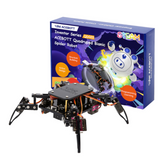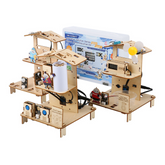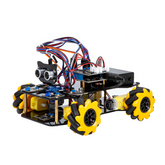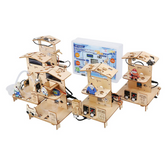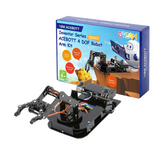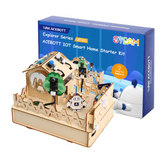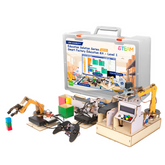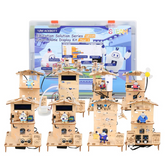Setup a Robotics Lab in School – Complete Guide 2025
Summary
Setting up a futuristic Robotics Lab in the classroom is one of the most effective ways to motivate students via hands-on learning. It transforms boring lectures into interesting, hands-on experiences that prepare students for their future careers.
However, many schools and institutions face a common problem: their robotics learning labs are less interesting than desired. Why? Because the lab design and STEM kits do not spark curiosity or creativity as they should.
To create a robotic lab that truly excites students and delivers real educational value, careful planning is essential.
In this blog, I’ll show you how to design a high-tech, highly engaging robotics lab that your students will love and truly boost their skills and passion for robotics.

What is a Robotics Lab in School?
A robotics lab is a special classroom where students learn to build and program robots. They learn to solve real-world problems using robotics kits. Students work with technologies like sensors and actuators and learn how to instruct how to control the behaviour of the robots through coding.
Unlike regular classrooms, robotics labs focus on hands-on learning. In a robotics education lab, the students don't simply read and listen in a passive manner. Instead, they get to get their hands dirty by practically doing things.

Importance of Robotics Lab Setup
Students today are growing up in a world with computers and AI. Technology is everywhere around them. But many schools are still educating in old ways and have not changed. This is a big problem for our children's future.
Robotics labs provide students hands-on experience. It gives them experience with real technology. They learn to build and learn to program. These skills are exactly what companies are looking for today.
India is rapidly moving towards becoming a manufacturing and production hub for the next generation of advanced technologies like Elective Vehicles and Semiconductors.
These technologies require advanced industrial automation and robotics technologies.
As a result, there will be high demand for jobs that require candidates that are highly skilled in robotics.
This opens up a massive opportunity for students that are equipped with the knowledge of Robotics.
Without robotics education, our students will struggle to compete in tomorrow's job market. So, every school must have a robotics lab by 2025 to provide engineering skills for kids.
Step-by-Step Guide to Setup a Robotics Lab in School
Planning Your Robotics Lab Setup
Setting up a educational robotics lab needs careful planning. You cannot just buy some robots and expect magic to happen. Many schools make this mistake and then wonder why their lab doesn't work properly.
First, decide what age groups will use the lab. Primary school students need different equipment from high school students. Also, think about how many students will use the lab at one time. This affects everything from space to the number of kits you need.
Make a list of your goals. Do you want students to learn basic coding? Or advanced engineering? Your goals will guide all other decisions. Talk to teachers who will actually use the lab. They know what works and what doesn't work in real classrooms.
Robotics Lab Requirements and Infrastructure Setup
Your robotics lab needs proper space and setup. A normal classroom won't work for robotics projects. Students need room to move around and test their robotics kits.
Each table should have power outlets for charging robots and laptops. Good lighting is very important because students work with small parts.
Internet connection must be strong and reliable. Many robotics kits need software downloads and updates. Weak WiFi will frustrate both teachers and students. Also, install a projector or smart board for demonstrations.
Budget Planning and Funding Sources for Robotics Lab
Money is the biggest worry for most schools. A basic robotics lab can cost anywhere from 3 lakh to 10 lakhs, depending on your needs.
If you are setting up a Robotics & STEM lab for the first time, you might be intimidated by the large number of options available in terms of equipment and providers. But don’t let that scare you. The goal is to approach this step by step.
The ideal way to go about setting up a robotics education lab would be not to try to build everything at once. Start small and expand over time. This spreads costs and helps you learn what works best.
Let’s get into it in more detail
Phase 1 (Budget: around 3 lakhs): Phase 1 should focus on basic infrastructure and simple materials. In this phase, focus on the fundamental infrastructure setup for the lab, such as setting up the bench, electrical wiring, and a reliable internet connection. In terms of lab equipment, bring in the basic electronic components such as LEDs, Breadboards, Resistors, Jumper Wires and introductory Robotics Kits.
Phase 2 (Budget 3 lakhs to 5 lakhs): During Phase 2, you can add additional tools and kits that require more effort from the students. You can include kits that require students to assemble their own robots instead of using pre-assembled robots. And then program these robots to perform basic movements.
Phase 3 (Budget 5 lakhs and beyond): During phase 3, you can add advanced kits and equipment such as Raspberry Pi kits, quadruped kits etc., that teach advanced skills such as image recognition and Machine Learning.
Now, let’s move towards funding. Once you’ve decided on a budget, the next question is, where are you going to get the funding from? Here’s a guide for different sources that you can look for fundraising:
- Look for government schemes that support STEM education.
- Government programs like the Atal Tinkering Lab initiative provide significant financial support for STEM lab projects. The program offers up to Rs. 20 lakhs. It gives this over a period of 5 years
-
AICTE IDEA Lab is another government scheme that provides substantial funding.
- Corporate CSR funds are another good option. Tech Companies often fund school projects.
Apply to multiple sources at the same time. Keep detailed records of all expenses. This helps when applying for future funding.
Robotics Lab Equipment and Robotics Kits Selection
Choosing the right robotics kits for schools is tricky. There are too many options in the market. Stick to well-known brands that offer good support in India.
- For primary school students, start with simple kits like ACEBOTT Smart Car Kit or Arduino kits.
- High school students can handle more complex platforms.
- Buy extra sensors and motors because students will break things.
- One great option for a well known brand for Robotics Kits is ACEBOTT. They provide STEM kits and equipment for different skill levels.
For primary school students, aged between 5 to 8 years, who require simple ACEBOTT kits, such as:

Smart Car Kit
This smart car kit will help the students to create and program your first self-driving car. Students can learn about basic programming while building something they can drive around. The DIY robot car kit comes with all necessary parts and step-by-step instructions that make the learning process easy.
Smart Farm Kit
This smart farm kit will help the student to build smart farming systems using sensors. The students can understand how modern agriculture works with technology. They can monitor soil moisture and automate watering systems.
Weather Station Kit
This weather station kit will teach the students to collect and study weather data through IoT technology. The students can build their own weather monitoring system that is connected to the internet.
With these basic STEM kits, they can learn about sensors, data collection, and how weather forecasting actually works.
For upper primary school students who are aged between 9 to 13 years, you can use the following kits:

Smart Factory Kit
This Smart Factory kit will help the students to learn about robotics and manufacturing processes. The students can understand how real factories work with automated machines. They can build their own mini production line and program robots to do different tasks like real industrial workers.
Smart Transportation Kit
This Smart Transportation kit will help the students to design smart city transportation solutions. The students can learn about how traffic lights work and how to manage city transport systems. They can learn to build models of smart buses and traffic control systems that solve real city problems.
Smart Home Kit
This Smart Home kit will help the students to learn about automation and programming through practical applications. Students can make their own smart house with automatic lights and security systems. They can control everything from their phone, just like modern smart homes that rich people have.
For high school students, aged 14 to 18 years, who can handle complex projects, you can use the following advanced level kits:

Spider Robot Kit
This Spider Robot kit will help the students to learn about complex locomotion and robotics engineering. The students can build a robot that walks like a real spider with many legs. They can understand how difficult it is to make robots move like animals and insects in nature.
Robotic Arm Kit
This Robotic Arm kit will help the students to learn about industrial control and mechanical systems. The students can build their own robot arm that can pick and place objects with precision. They can program it to do tasks like real factory robots that assemble cars and electronics.
Bionic Biped Robot Kit
This Bionic Biped Robot kit will help the students to learn how to engineer human-inspired movement with advanced tutorials. The students can build a robot that walks on two legs like humans do. They can understand about the complex programming that is needed to make robots balance and walk without falling down.
Also, don't forget about computers or tablets. Each group of 2-3 students needs one device for programming. Basic laptops work fine, you don't need expensive machines.
Start Your Robotics Lab the Right Way – Get Official ACEBOTT Kits at Robocraze
Curriculum Development and Learning Objectives for Robotics Lab
Your robotics lab needs a proper robotics curriculum. Random activities won't give good results. Plan lessons that build on each other gradually.
Start with basic concepts. These concepts can include topics like sensors and simple programming. Then move to problem-solving projects. Try to connect robotics to different scientific subjects. This makes learning more meaningful.
Set clear learning goals for each grade. What should a Class 6 student know? What about Class 10? Having clear targets helps teachers plan better lessons.
It's better to follow the New Education Policy (NEP) 2020 curriculum to equip your students with 21st-century skills.
Teacher Training and Staff Preparation

Teachers are the most important part of your robotics lab. Even the best equipment is of little value without trained teachers. If you ignore this, then you are at a risk of providing your students with sub-par education. Because the curriculum is only as good as the teacher teaching it.
To ensure that your faculty is fully prepared, invest in a proper training plan for the teachers. The training program should ensure that the teachers learn both technical skills as well as the teaching methods.
You can choose our FDP Program to train your teachers.
Our FDPs are carefully crafted to provide faculty members from K-12 schools and engineering colleges with deep insights and practical skills in setting up and utilizing STEM, Robotics, IoT and AI/ML lab kits.
Safety Protocols and Robotics Lab Management
Safety comes first in any robotics learning lab. Students work with electrical components and moving parts. Small accidents can happen if you're not careful.
Make clear rules about handling equipment. For example,
- Use surge-protected power strips, conceal exposed wires, and prevent overloading circuits.
- Install a main emergency kill switch for quickly powering down all devices.
- Keep a first aid kit ready always. Have a teacher supervise all activities.
- Create a system for checking equipment before and after each class. This prevents damage and keeps everything organized.
- Use anti-static mats and wristbands when working on sensitive electronics.
- Ensure students follow a checklist to shut down robots, unplug equipment, and clean up the workspace after each session.
Implementation Timeline and Phases for Robotics Lab
Don't try to start everything at once. Break your implementation into phases.
- Phase 1 should focus on basic setup and teacher training.
- Phase 2 can introduce robotics to younger students.
- Phase 3 expands to all grades with advanced projects.
Give yourself at least 6 months for complete implementation. Rushing leads to problems that are hard to fix later.
Common Challenges and Solutions in Robotics Lab
Every school faces similar problems when setting up robotics labs. One of the most common issues is teacher resistance. Many teachers are reluctant to adopt a new technology into their teaching process.
Every school faces similar problems when setup robotics labs. The most common issue is teacher resistance. Many teachers feel scared of new technology.
The solution is proper faculty training and gradual introduction. Let enthusiastic teachers start first, others will follow when they see positive results.
Equipment breakage is another big problem. Students are not always careful with expensive kits. Budget for repairs and replacements from the beginning. Having spare parts and electronic components saves a lot of headaches.
Best Strategy to Setup a Robotics Labs in 2025

Robocraze has more than 10 years of expertise and has successfully set up 1000+ high-tech STEM and Robotics Labs across India. We know how difficult it can be to start from zero. That's why we work with you every step of the way.
We have helped many famous schools and colleges to setup labs and training teachers like IIT Bombay, Manipal Institute of Technology, T John group of Institutions, IIT Delhi, and many more. Our team knows exactly what works and what doesn't work in Indian schools. We provide complete solutions from highly engaging equipment to teacher training.
Contact Robocraze today Call +91 9100088099 or Mail connect@robocraze.com and let us help you build the robotics lab your students deserve.
Conclusion
Setting up a robotics lab is not easy, but it's necessary for your school's future. Your students deserve the best education possible. Don't let them fall behind because of outdated teaching methods.
Start planning today. Follow this step-by-step guide. With proper planning and execution, your robot lab will become the pride of your school.



